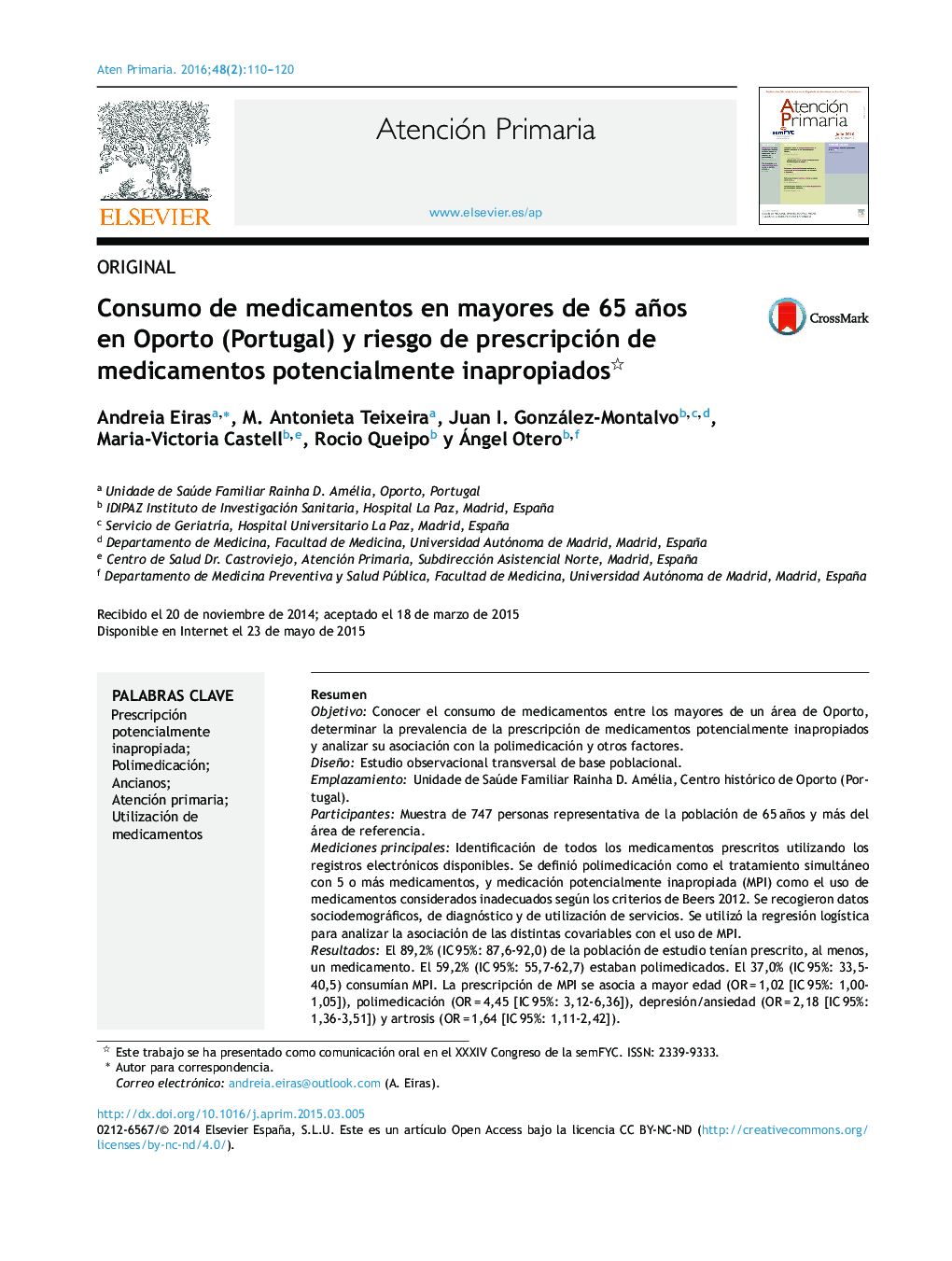| Article ID | Journal | Published Year | Pages | File Type |
|---|---|---|---|---|
| 3457025 | Atención Primaria | 2016 | 11 Pages |
ResumenObjetivoConocer el consumo de medicamentos entre los mayores de un área de Oporto, determinar la prevalencia de la prescripción de medicamentos potencialmente inapropiados y analizar su asociación con la polimedicación y otros factores.DiseñoEstudio observacional transversal de base poblacional.EmplazamientoUnidade de Saúde Familiar Rainha D. Amélia, Centro histórico de Oporto (Portugal).ParticipantesMuestra de 747 personas representativa de la población de 65 años y más del área de referencia.Mediciones principalesIdentificación de todos los medicamentos prescritos utilizando los registros electrónicos disponibles. Se definió polimedicación como el tratamiento simultáneo con 5 o más medicamentos, y medicación potencialmente inapropiada (MPI) como el uso de medicamentos considerados inadecuados según los criterios de Beers 2012. Se recogieron datos sociodemográficos, de diagnóstico y de utilización de servicios. Se utilizó la regresión logística para analizar la asociación de las distintas covariables con el uso de MPI.ResultadosEl 89,2% (IC 95%: 87,6-92,0) de la población de estudio tenían prescrito, al menos, un medicamento. El 59,2% (IC 95%: 55,7-62,7) estaban polimedicados. El 37,0% (IC 95%: 33,5-40,5) consumían MPI. La prescripción de MPI se asocia a mayor edad (OR = 1,02 [IC 95%: 1,00-1,05]), polimedicación (OR = 4,45 [IC 95%: 3,12-6,36]), depresión/ansiedad (OR = 2,18 [IC 95%: 1,36-3,51]) y artrosis (OR = 1,64 [IC 95%: 1,11-2,42]).ConclusionesLa prescripción de fármacos, polimedicación y uso de MPI son muy elevados en la población portuguesa estudiada. La polimedicación es el factor más importante asociado al consumo de MPI. La prescripción de ansiolíticos, antidepresivos o antiinflamatorios debe hacerse con mucho cuidado ante el riesgo de los MPI.
ObjectiveTo determine medication consumption in the older people from a central area of Oporto; determine the prevalence of prescription of Potentially Inappropriate Medication and to analyse the polypharmacy and other important connected factors.Design, setting and patientsCross-sectional study with a sample of 747 patients older than 64 years, who were attended in a Primary care health centre: USF Rainha D. Amélia, Oporto, Portugal.Main outcome measuresidentification of all medication prescribed from electronic registers. Polypharmacy was considered more than 5 medication prescribed and Potential Inappropriate Medication was identified by Beers criteria 2012. The socio-demographic factors, diagnosis and health care services use were registered too. Logistic regression analysis was used to determine the association between co-variables.ResultsThere were 89.2% (95% CI: 87.6-92.0) of the studied population with at least one prescription. The polypharmacy was present at 59.2% (95% CI: 55.7-62.7) of people. The Potential Inappropriate Medication was present in 37.0% (95% CI: 33.5-40.5) of the cases. The Potential Inappropriate Medication was related with increasing age [OR = 1.02 (95% CI: 1.00-1.05)], polypharmacy [OR = 4.45 (95% CI: 3.12-6.36)], and be diagnosed with depression/anxiety [OR = 2.18 (95% CI: 1.36-3.51)] and/or arthrosis [OR = 1.64 (95% CI: 1.11-2.42)].ConclusionThe rate of medication prescription, polypharmacy and the prescription of Potentially Inappropriate Medication are very high in Portuguese population studied. The polypharmacy is the most important factor related with this potential inappropriate medication. The physician need to have carefully with prescription of the anxiolytic and anti-inflammatory pain drugs.
